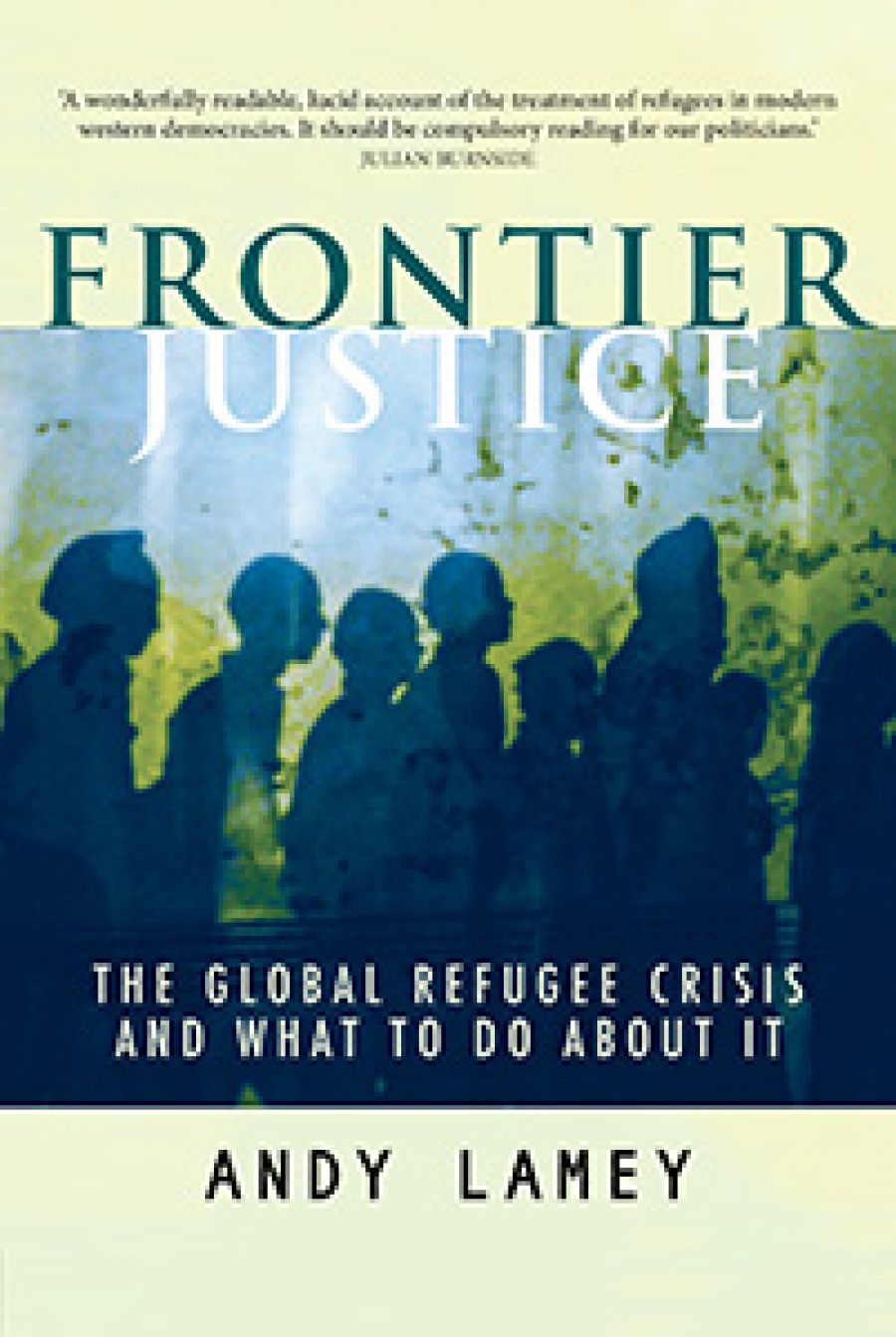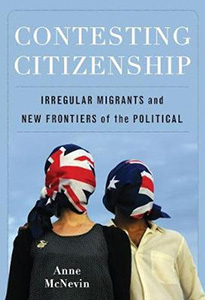
- Free Article: No
- Contents Category: Politics
- Custom Article Title: Peter Mares reviews 'Frontier Justice' by Andy Lamey and 'Contesting Citizenship' by Anne McNevin
- Review Article: Yes
- Online Only: No
- Custom Highlight Text:
Australian advocates of a harsh line against asylum seekers arriving by boat often base their arguments on a concern for the protection of human life. Unless we deter boat people, so the reasoning goes, ever greater numbers will set out on the dangerous voyage from Indonesia, and more and more lives will be lost at sea. This may sound like a novel position, but, as Andy Lamey makes clear in Frontier Justice: The Global Refugee Crisis and What to Do about It, the argument is well worn. In the early 1990s, Presidents Bush Sr and Clinton used similar justifications to defend a policy of intercepting boats from Haiti and returning them directly to Port au Prince, without making any assessment as to whether those on board might have claims to protection from Haiti’s dictatorial régime.
- Book 1 Title: Frontier Justice
- Book 1 Subtitle: The global refugee crisis and what to do about it
- Book 1 Biblio: University of Queensland Press, $34.95 pb, 416 pp,
- Book 1 Readings Link: https://www.booktopia.com.au/frontier-justice-andy-lamey/book/9780702239311.html
- Book 2 Title: Contesting Citizenship
- Book 2 Subtitle: Irregular migrants and new frontiers of the political
- Book 2 Biblio: Columbia University Press (Footprint Books), $68 hb, 240 pp,
- Book 2 Cover Small (400 x 600):

- Book 2 Cover (800 x 1200):

- Book 2 Readings Link: https://www.booktopia.com.au/contesting-citizenship-anne-mcnevin/book/9780231151283.html
During the 1992 presidential campaign, Bill Clinton had promised to reverse the Bush repatriation policy. Once elected, he changed his mind. The catalyst was a CIA briefing that included satellite photographs of Haitians cutting down trees to make boats. Clinton was warned that if he fulfilled his campaign promise to process Haitian asylum seekers on American soil, ‘he would be responsible for a hundred thousand people taking to the seas in all manner of craft, up to ten thousand of whom could be expected to die in the crossing’.
There are echoes of the Australian experience here. In 1999, Immigration Minister Philip Ruddock warned of intelligence that thousands of ‘illegal immigrants’ were threatening to flood Australia: ‘The information that is available to us suggests that whole villages are packing up and there is a pipeline. If it was a national emergency several weeks ago, it’s gone up something like ten points on the Richter scale since then.’
It is not unreasonable for policy makers to be concerned that treating asylum seekers in line with international treaty obligations might encourage further risky voyages and result in more lives lost at sea. Certainly, it is difficult to argue that the ideal pathway to refugee protection runs via people smugglers and leaky boats. The question is whether the harsh treatment of those who do arrive in this way will do anything to change the situation.
Using case studies from the United States, Canada and the European Union – as well as Australia – Lamey helps broaden our parochial horizon on the refugee dilemma and demonstrates how self-serving official justifications for tough policies can be. For example, Cuban asylum seekers attempting to reach US beaches have always been treated more favourably than Haitians. The differential treatment has nothing to do with the relative merits of their potential asylum claims or the relative risk of loss of life at sea on leaky boats. Rather, it is driven entirely by the exigencies of US domestic politics and by the power of émigré Cuban voting blocks in key constituencies like Florida. This is one example of what Lamey calls the ‘organised hypocrisy’ of global refugee policies. Governments espouse high principles in theory, but find ingenious ways to avoid answering the refugee’s call for help in practice.
Lamey also demonstrates that harsh border control measures can be self-defeating when individual states act in isolation, rather than confronting the international nature of the problem:
There have been situations, for example, where one country had deliberately made its asylum program less welcoming in the hope of attracting fewer refugee claimants, only to see the number of applications go up instead – because neighbouring countries have simultaneously made their own policies even harsher.
The result is a ‘race to the bottom’ that increases the risks facing refugees.
When rich nations such as Australia and the United States curtail the protection they extend to refugees, governments in Asia and Africa are inspired to invoke similarly harsh measures. After the US Supreme Court upheld the legality of the Haitian interdiction policy, Tanzania (previously one of the more generous nations in Africa) closed its border to people fleeing Burundi. Tanzania’s foreign minister singled out the US interdiction policy as a precedent that had inspired his government’s change of heart.
However, Frontier Justice is not just a litany of examples of the failure of national governments to live up to the obligations enshrined in the Refugee Convention. The guiding idea in the book is Lamey’s attempt to counter the pessimism of Hannah Arendt, who dismissed the validity of a rights-based approach to justice.
For Arendt, who fled the Nazis, the experience of being a stateless refugee exposed a gaping flaw in the ideal that every human being ‘is born with inalienable and indefeasible rights’. She lamented that such rights ‘proved to be unenforceable [...] whenever people appeared who were no longer citizens of any sovereign state’. Human beings are not born with rights, she concluded, but acquire them as result of membership of a political community. Despite the ‘universal’ rhetoric, a state only upholds the rights of its own citizens. As Lamey summarises Arendt: ‘Refugees are human beings who are in essence citizens of nowhere. Which is to say, they are human beings with no rights worth speaking of.’
Many of the examples in Frontier Justice only seem to confirm the validity of Arendt’s gloomy thesis, yet Lamey nevertheless manages to reach a cautiously positive conclusion. While recognising that citizens expect government to control the frontier, he argues that border control is not necessarily incompatible with respect for human rights. Based on the Canadian experience, he puts forward a ‘portable-procedural’ model of refugee processing that would enforce three crucial rights of asylum seekers: the right to a fair, oral hearing of their claim, the right to legal representation, and the right to appeal the decision. (I assume from Lamey’s critique of Australia’s policies that his ‘portable procedural’ model would also exclude the possibility of mandatory, indefinite, and non-reviewable detention.) Such a model does not call into question ‘a state’s prerogative to control its borders’, but would ‘extend to asylum seekers three procedural entitlements that we take for granted when it comes to the rights of citizens ...’
If Australia were to adopt such an approach, it could still interdict maritime asylum seekers and send them elsewhere for processing, but only to jurisdictions that upheld the three legal standards enshrined in the portable-procedural model.
Lamey admits that such a system would not be flawless, but argues that it is the most realistic option for ‘reconciling the existence of sovereign states with the aspiration of human rights’.
Anne McNevin, in her book Contesting Citizenship: Irregular Migrants and New Frontiers of the Political, also offers an optimistic response to Arendt’s refugee dilemma: that the ‘right to have rights’ only comes with citizenship. However, McNevin’s focus extends beyond refugees to include ‘irregular migrants’ of all kinds: that is, anyone who crosses a border without official permission. Unlike Lamey, she does not attempt to offer practical policy prescriptions within the existing framework of nation states, borders, and citizenship. Rather, she is interested in the way those categories are being recast by global processes.
Borders, for example, are no longer neatly aligned with the physical territory of a state. We see this in places as diverse as Christmas Island, which has been excised from the Australian migration zone, and the City of London, which, in order to attract financial traffic, was transformed into an ‘offshore’ zone, with a separate regulatory and taxation system from the rest of the United Kingdom.
There is a different kind of ‘organised hypocrisy’ at work here, where ‘fast tracked border crossings for certain commodities and persons are connected to heightened surveillance of others’. While national governments extol the virtues of globalisation, the reality is that ‘some people are welcome everywhere and others nowhere’ (depending largely on the colour of your passport or the size of your bank balance).
McNevin argues that these apparent contradictions are driven by the same economic and political logic. Illegality helps make undocumented workers attractive to US employers, because it creates a pool of labour that is ‘highly mobile, seemingly impervious to wage regulations, and easily expendable according to market fluctuations’. Yet the unsettling effects of globalisation make it essential for government to continue to emphasise the ‘performance’ of border control in order to reassert the legitimacy of the state. Policing the frontier projects ‘an image of control’, upholds ‘the continued significance of sovereign territorial borders’, and confirms the state’s role in ‘defining and protecting’ citizens.
While highly publicised attempts are made to detect and deport ‘illegals’, the crucial role of irregular migrants in the economy requires that such efforts can never be too successful. The contradiction is neatly captured in a joke by stand-up comedian Paul Rodriguez: ‘I’m all for building a wall at the border [...] But I’m concerned about who’s going to build it. The last white guy in construction was in the Village People.’
McNevin’s optimism comes from exactly this type of response. Using the United States and France as examples, she describes the ways in which irregular migrants are organising themselves to resist exploitation and assert their rights. In the short term, the immediate aim of such struggles is the regularisation of status as undocumented migrants seek admittance to the charmed circle of citizenship and the benefits that it confers.
But McNevin argues that regularisation only serves to reboot the system and to consign subsequent waves of irregular migrants to the same netherworld of illegality. Her eye is on the bigger picture: on the way a simple mapping of citizenship and territorial boundaries is being exploded and replaced by a more complex layering of ‘modes of political belonging’. So when undocumented students mobilise on Californian campuses, ‘they ritualise those places in new ways, embedding their presence as “irregular citizens” in traditions of civil rights activism that become part and parcel of a powerful story of U.S. citizenship’. This creates a space in which ‘counternarratives of “who we are” and “where we belong” can emerge and gain traction’.
This assertion of new modes of belonging is encapsulated by a slogan worn by undocumented migrants at protest rallies: ‘I’m illegal. So what?’ While McNevin does not attempt to predict where these processes will lead, she sees it as a ‘creative moment’ that will ‘outrun our current political imagination’.


Comments powered by CComment